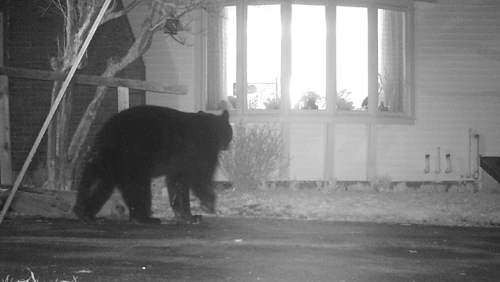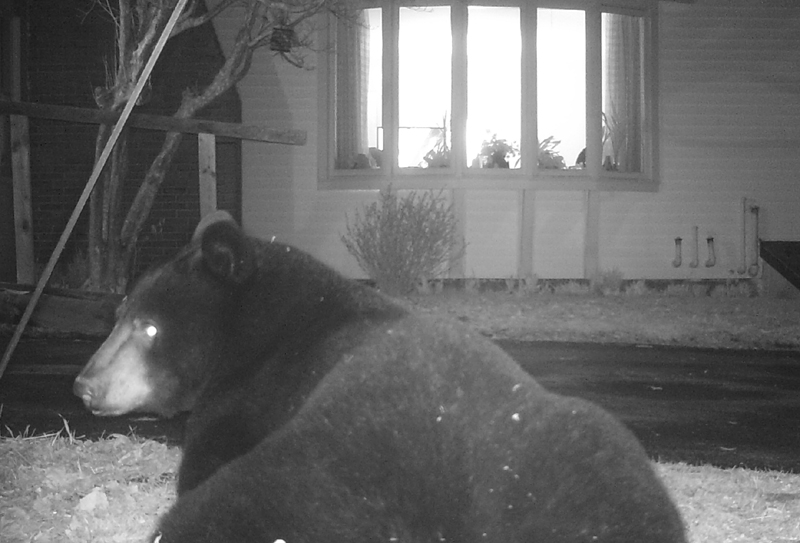WAYNE — When one bird feeder was pulled down and dragged yards away from Priscilla Stevenson’s house, a raccoon was suspected.
But the next night, a tenant who lives at the Walton Road home saw a bear going after another bird feeder.
Using a motion-activated camera, Priscilla’s son, Ford Stevenson, captured images of the big bear on Saturday night when it returned for a third bird feeder and birdseed scattered on the ground.
Some of the pictures show the bear standing near the window of the living room where Ford Stevenson’s 96-year-old mother was watching TV.
“She’s a little rattled by it, to think she was sitting there and she didn’t know what was happening,” he said.
The bear, which Ford Stevenson estimated stands about 3 feet tall at the shoulder, also destroyed several beehives on the property near Walton Road.
Bird feeders, beehives, grills and garbage are typical targets for bears emerging from their dens at this time of year, when other food is not readily available, said Jennifer Vashon, a biologist with the Department of Inland Fisheries and Wildlife.
“In the springtime, we usually have the height of our bear complaints,” Vashon said. “There’s not a lot of natural foods out there. But when the berry crop starts to ripen, there are fewer complaints.”
The wildlife department released advice on Wednesday about avoiding bear conflicts. The release says that because of an early spring in 2012, the Maine Warden Service received 870 bear-related complaints, compared to 436 in 2011 and 395 in 2010.
Vashon said nothing about the weather leads her to believe there will be an unusual number of bear complaints this year, but it’s important to take a community-based approach to keep from attracting bears.
“If one neighbor brings in their bird feeders and makes sure that their garbage remains inside until the morning of trash pickup, but their neighbor doesn’t, then there’s going to continue to be bear problems in the community,” she said.
Once a bear associates a particular neighborhood with food, it will keep returning, Vashon said.
The wildlife department recommends taking down bird feeders between April 1 and Nov. 1 and raking up birdseed from the ground. They also say to store pet and livestock food inside and to stop grilling if there are bear problems in the area so that the bear will move on.
If a bear gets into a shed or a garage, stay away to give it an escape route, Vashon said. If a bear is in an open space such as a yard, stay inside or make loud noises when going outside to scare it away.
Ford Stevenson said his mother’s bird feeders have been put away, and the owner of the beehives installed electric fencing around them.
“He hasn’t been back for three nights, so maybe he moved on,” Ford Stevenson said. “Who knows? He may be raiding someone else’s bird feeder.”
Susan McMillan — 621-5645
smcmillan@mainetoday.com
Send questions/comments to the editors.




Success. Please wait for the page to reload. If the page does not reload within 5 seconds, please refresh the page.
Enter your email and password to access comments.
Hi, to comment on stories you must . This profile is in addition to your subscription and website login.
Already have a commenting profile? .
Invalid username/password.
Please check your email to confirm and complete your registration.
Only subscribers are eligible to post comments. Please subscribe or login first for digital access. Here’s why.
Use the form below to reset your password. When you've submitted your account email, we will send an email with a reset code.